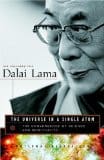 The Universe in a Single Atom: The Convergence of Science and Spirituality, by H.H. Tenzin Gyasto, the 14th Dalai Lama
The Universe in a Single Atom: The Convergence of Science and Spirituality, by H.H. Tenzin Gyasto, the 14th Dalai Lama
Broadway Books, 978767920810, 216 pp., 2005
Many books that touch on science and spirituality follow the pattern of using one to try to (dis)prove the other. In this book, while His Holiness seeks the middle path of Science and Spirituality, he doesn’t try to marry the results, but the process. Rather than trying to show how science is directly supporting or opposing Buddhist thought, he spends the time focused on the process of science and the importance it holds to Buddhism, as well as how Buddhism must change with the understanding of our world.
“My confidence in venturing into science lies in my basic belief that as in science so in Buddhism, understanding the nature of reality is pursued by means of critical investigation: if scientific analysis were conclusively to demonstrate certain claims in Buddhism to be false, then we must accept the finds of science and abandon those claims.”1
His Holiness so believes in this, that at the Buddhist colleges in Dharmasala, where Lamas train, physics has become a necessary part of the curriculum, along side debating, meditation, linguistics, theology and the variety of subjects more traditionally associated with being a monk. Modern particle physics is replacing the atomic theories of Vasubandhu, which in light of new discoveries he considers “crude models”2 but none the less “on the right track.”3
Buddhism, at its heart is a scientific philosophy, based in scepticism, testing ideas, and searching for evidence, rather than fostering belief, and after exploring the benefits that modern empirical science holds for Buddhist thought, the Dalai Lama moves into comparing more of the findings, than just the practice.
His Holiness makes an interesting point, noting the similarities between Newtonian Physics, and the Buddhist idea of Conventional Truth; and Quantum Physics with the idea of Ultimate Truth. In both cases of the former, it refers to one level of meaning or reality that is how we experience the world as a real and solid thing, and the latter cases the focus is on how beneath this solid reality is really a world working under a drastically different set of laws where nothing is as solid as it once seemed.4
The Dalai Lama always struck me as a progressive man, aware of where the beliefs of his tradition applied, and where they don’t. I first realized this when reading his book Mind of Clear Light and he mentioned that in the Tibetan Buddhist tradition between lives a consciousness will see their next parents engaged in sex and be drawn into the body, but in the modern day things like in vitro fertilization means that this belief is incomplete, and should be rethought.5 I find it very refreshing to read of a leader of a spiritual tradition who not only understands the value of accepting modern understandings of reality, but is willing to let go of beliefs ingrained in the tradition for hundreds or in some cases thousands of years. He doesn’t do so blindly and with haste though, for example he believes “that Buddhism must abandon many aspects of the Abhidharma cosmology”6, but by the many aspects he is referring to literal interpretations, and he understands that on a symbolic level the cosmology is still a valid model for understanding the inner world, but not the outer.
He covers everything from particle physics to astronomy, the Big Bang to evolution, to cloning, covering everything with his standard humility, compassion and humour. It was a pleasure to read his views on science and the modern world, as well as his hopes and fears for where humanity is headed.








